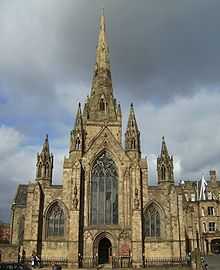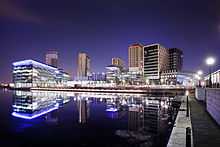Oliver Heywood
| Oliver Heywood | |
|---|---|
 Oliver Heywood Memorial in Salford | |
| Born | 9 September 1825 |
| Died | 1892 (aged 66) |
| Occupation | British banker |

Oliver Heywood (9 September 1825 – 1892) was an English banker and philanthropist.
Born in Irlam, Lancashire, the son of Benjamin Heywood, and educated at Eton College, Heywood joined the family business, Heywood's Bank in the 1840s.
Heywood sponsored many philanthropic causes, including Manchester Mechanics' Institute, Chetham's Hospital, Manchester Grammar School and Owens College. He was selected as High Sheriff of Lancashire for 1888.
He married Eleanor Barton, daughter of Richard Watson Barton, on 7 September 1847; they had no children.[1]
Life
On 9 September 1825, Oliver Heywood was born in Irlams O' Th' Height near Manchester, England to the prominent English banker and well known philanthropist Sir Benjamin Heywood and his wife Sophia Ann Robinson. Heywood was born into a very wealthy and prominent English family. His family had made their fortune during the 1800s in Banking. The Heywood bank was one of the more recognizable bank names in Manchester; it was located in St. Ann's Square. However, the Heywood legacy had endured some tarnishment from the 1700s.
Heywood was educated in Liverpool at St. Domingo House, at the time, a boarding school for boys that was housed by a Large Mansion. He then was educated at Mr. Mertz School in Manchester and then at Eton for his higher education. Heywood followed the finishing of his formal education by traveling abroad before beginning his very promising career in the family business...banking.[2]
On 7 September 1847, Heywood married Eleanor Barton, the daughter of a merchant from Pendlebury named Richard Watson Barton. The couple first lived in Acresfield in the house were Heywood had been born in Irlams O' Th' Height near Manchester. However, after the death of Sir Benjamin Heywood in 1865, Heywood and Barton would move into his house nearby in Claremont. Despite their thirty-year marriage, Heywood and Barton would bare no children, She died in September 1877.
Heritage
Oliver Heywood has lineage that's traced back to the 1700s; an ancestry that has tarnished the Heywood legacy. Heywood family fortunes have ties to the Trans-Atlantic Slave trade. In the 1700s, members of the Heywood family had made their home in Liverpool and owned a shipping company. The Heywoods would transport goods made in Manchester, England to West Africa to trade for African slaves. From West Africa, the Heywood ships would take them to Barbados in the Caribbean. In Barbados, the Heywood ships would then trade the African slaves for sugar and cotton. The ships would then bring the sugar and cotton back to Liverpool.
In the 1840s, By the time Oliver Heywood had joined the family business, the infamous history from the 1700s had been more or less forgotten within the family. In England, even during the 1700s, the slave trade was regarded as a less than honorable way to carry on in life. In the 1740s, it was Oliver Heywood's great-grandfather, Benjamin Heywood, that would entangle himself as a young merchant in what was called at the time the "Triangular Transatlantic Trade" with his older brother, Arthur. The slave trade was highly lucrative but considered unscrupulous. It was from the fortunes that were made by Benjamin Heywood's notorious slave trades that he would be able to establish the family bank in Manchester in 1788.
Business
In 1845, Heywood would join his father's firm, Sir Benjamin Heywood & Co., a banking company. In 1847, approximately two year after he joined the family business, Heywood was made a partner in his father's company; subsequently his three younger brothers would also be made partners in their father's business. In 1860, Sir Benjamin Heywood retired from his company and made his oldest son, Oliver, the senior partner of the bank. It was after this transition that the Heywood bank would be renamed from "Sir Benjamin Heywood & Co." to "Heywood Brothers & Co.".
Under Oliver Heywood's leadership, Heywood Brothers & Company fulfilled his father's legacy within the business; the bank kept its reputation that it had earned for reliability and prudence. These two particular qualities would prove to be both tested, then after reaffirmed, to be defining for the bank's survival during the financial crisis of 1866. In 1866, the financial crisis was spurred by the collapse of an old and prestigious banking firm "Overend, Gurney & Co."; this major bankruptcy caused a serious panic within the English banking sector.[3]
Oliver Heywood was in London at the time when the crisis first struck. He witnessed all the panic that had ensued after the bankruptcy of Overend, Gurney & Co.; the entire banking sector in London was in chaos. Heywood's first instinct was to hurry home to Manchester to check on the firm: Luckily everything at the firm had been copacetic, just how he left it. The firm's well-weathering of the financial crisis of 1866 is largely given credit to how Heywood managed his company, he was reliable and prudent. Never taking a risk that was too dangerous or that would over-extend the firm financially.[4]
In 1876, Oliver Heywood would remain the senior partner of Heywood Brothers & Co. until the firm would get acquired by Manchester & Salford Bank. As part of the agreement made in the acquisition, there was an arrangement that Heywood and his three younger brothers would continue to hold high ranking positions in Manchester & Salford Bank. The arrangement made Heywood and his brothers directors in their new firm, the Manchester & Salford Bank.[5]
In 1878, Heywood had retired all his obligations, beyond being a shareholder, to the Manchester & Salford Bank. This virtually meant that he stopped attending the board meetings that were required of a member of the Board of Directors; and in turn was not re-elected to the firm's board. Heywood's reasoning for no longer attending the board meetings came from a place of disapproval with the Firm's general manager Thomas Read Wilkinson's recent acquisition. Wilkinson had made the decision to purchase Hardcastle, Cross & Co., the bank that was located in Bolton.
Philanthropy
Oliver Heywood's family bank was very successful during the Victorian era. The prosperity from the Heywood Bank rewarded the family handsomely, the amount of wealth Heywood was receiving allowed him to have more time and focus on charitable and philanthropic work. These righteous pursuits also included but were not only limited to liberal causes in Salford and Manchester. Heywood's philanthropic interests had a particular focus in education. He started off supporting and financing for projects to erect and establish working men's colleges. Heywood even assisted his resources to help erect and establish the Owens College, which had eventually became a forerunner of the University of Manchester. Heywood's philanthropic pursuits were looked at as very admirable considering that many of his contemporaries were disinterested in public duties. His contemporaries, or other people with substantial wealth, were moving out of the grimy cities to the more desirable country manor or suburban areas. Since a large portion of the wealthy were no longer living in the cities, this meant that consequently this sect of the wealthy was also less interested in providing charity for a community that they no longer inhabited. Heywood, deciding to stay in Manchester, and with his very generous inclinations, he was very prone to provide a little extra to his community's needs.
Some of Heywood's contributions and support he led to education were mainly in Manchester and included: Victoria University, Owens College, Manchester Grammar School, Manchester High School for Girls, Hulme Grammar School, Manchester Technical School, Manchester School Board, Salford School Board, and the Association for the Promotion of Technical Education in the Manchester District.
Heywood also provided his support and contributed to the healthcare organizations and facilities of Manchester, these include: Hospital for Sick Children, St Mary’s Hospital, Manchester Royal Infirmary, Salford Royal Hospital, the Royal Eye Hospital Manchester, the Royal Asylum, and the Provident Dispensaries Association.[6]
Heywood was passionate and often locally involved to the best of his capacity towards, what was then considered, "Progressive Causes". He was a staunch supporter of the Anti-Slavery movement in England, and in turn, the World. It wasn't considered rare or bizarre to find Heywood at local Anti-Slavery meetings in Manchester. One of the more notable anti-slavery meetings was held in November 1872, in Manchester had recorded the attendance of Heywood's presence. That meeting, in November 1872, was focused on the stopping of the African slave trade that was being carried out in East Africa.
Heywood's father, Sir Benjamin Heywood, was a parliamentary representative during the 1830s. Despite Heywood's father's political legacy and his own public record of charity and public service, Heywood never took a career in politics seriously. Heywood was admired for his subtle disposition and his high qualities of competence and generosity. It was only natural that Heywood was offered the parliamentary seat for Salford as the liberal candidate on multiple occasions; he turned all the proposition down, flattered.
Legacy
On 17 March 1892, Heywood died in his home. He was buried in Pendlebury at St. John's. The funeral production was vast and impressive: The bishops of Guildford and Manchester both conducted the service where thousands of people showed up to pay their respects and 150 carriages were used. On the afternoon of Heywood's funeral, shops in Irlams O' Th' Height and Pendlebury closed down in his honor.[7]
In 1888, Heywood's public work and sacrifice would be acknowledged by the city of Manchester making him the city's first Honorary Freeman. This accolade would be solidified by a statue that would be erected in Heywood's honor. The decision to build the statue was made after Heywood's death in 1892. The statue would be put up on public display in Albert Square in Manchester; it was made out of marble and commissioned to Albert Bruce-Joy for 2,600 English pounds. 332 donors contributed to make certain the proper funds were met to erect the statue.
Albert Bruce-Joy had previously sculpted a statue of John Bright in Albert Square, the committee behind the commission for Heywood's statue approved of Bruce-Joy's work on the previous statue. The committee believed that Bruce-Joy's statue of Heywood would complement that of the statue of Bright. In December 1894, the statue of Heywood was unveiled in Albert Square. A ceremony was held to commemorate Heywood and his new statue; the inscription on the statue states that his life was one "devoted to the public good".
Honours
- First Honorary Freeman of the City of Manchester, 1888
- A grade II listed statue by Albert Bruce-Joy stands in Albert Square, Manchester, unveiled 1894.[8]
- Memorial in Salford unveiled on the 20th of October 1893
References
- ↑ "The Peerage". Retrieved 13 February 2011.
- ↑ Williams Deacon’s, 1771–1970 (Manchester: privately published by Williams & Glyn’s Bank Ltd, 1971)
- ↑ ’Oliver Heywood and the Overend Gurney Crisis’, Three Banks Review, December 1951, vol. 12, pp. 29-40
- ↑ Oliver Heywood’s diary relating to the Overend Gurney crisis in 1866 is featured in RBS History 100
- ↑ T P Heywood, Reminiscences, Letters, and Journals of Thomas Percival Heywood, Baronet. Arranged by his eldest daughter (Isabel Mary). With a preface by the Rev. George Body. (Manchester: printed for private circulation, 1899)
- ↑ E Edwards, Manchester worthies and their foundations (Manchester: J. Galt & co, 1855)
- ↑ Report of funeral of Oliver Heywood, Manchester Courier and Lancashire General Advertiser, 22 March 1892
- ↑ "Oliver Heywood". Manchester Art Gallery. 2009. Retrieved 1 January 2012.
| Wikimedia Commons has media related to Oliver Heywood. |
- Statue of Oliver Heywood, Albert Square, Manchester; Terry Wyke; Revealing Histories; 2014
- Report of death, The Manchester Evening News, 17 March 1892
- Notice of death, Supplement to the Manchester Courier, 19 March 1892
| ||||||||||||||||||||||||||||||||||||||||||||||




